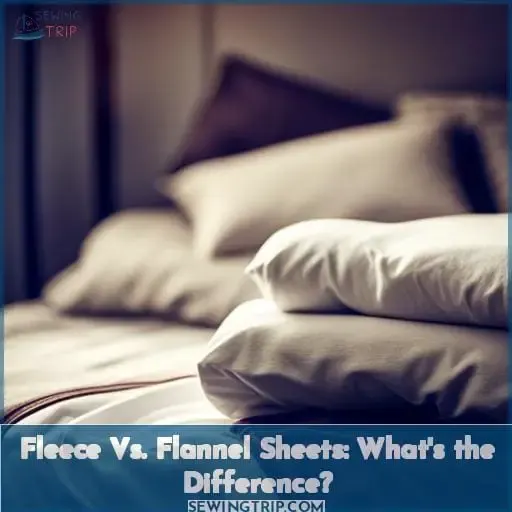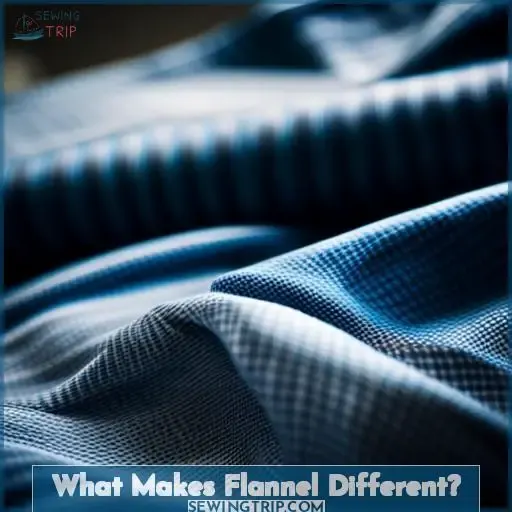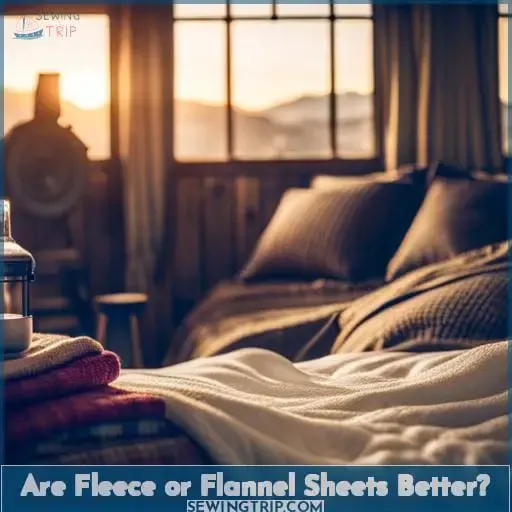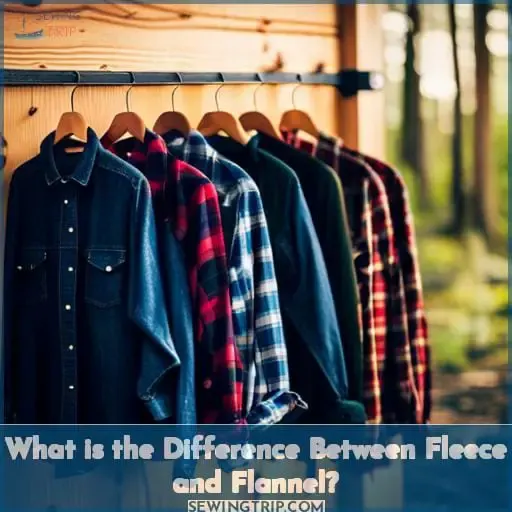This site is supported by our readers. We may earn a commission, at no cost to you, if you purchase through links.
 Looking to stay warm and cozy this winter? Fleece vs flannel, which fabric should you choose? In this article, we’ll explore the key differences between fleece and flannel, helping you make an informed decision about which one is right for you.
Looking to stay warm and cozy this winter? Fleece vs flannel, which fabric should you choose? In this article, we’ll explore the key differences between fleece and flannel, helping you make an informed decision about which one is right for you.
From softness to durability to breathability, we’ll cover it all. So whether you’re snuggling up in bed or heading outdoors in chilly weather, let’s dive into the world of fleece vs flannel and discover their unique benefits.
Table Of Contents
- Key Takeaways
- Fleece Vs. Flannel Sheets: What’s the Difference?
- What Makes Flannel Different?
- Are You a Hot Sleeper or a Cold Sleeper?
- Is Flannel Warmer Than Fleece?
- How Good Are You at Caring for Your Sheets?
- Does the Environment Factor Into Your Decision?
- Are Fleece or Flannel Sheets Better?
- What is the Difference Between Fleece and Flannel?
- Popular Products Made of Fleece and Flannel
- What is the Difference Between Fleece and Microfleece?
- Frequently Asked Questions (FAQs)
- Conclusion
Key Takeaways
- Fleece sheets are lighter and provide more warmth, while flannel sheets are heavier and offer less warmth.
- Fleece sheets are less expensive and easier to care for, while flannel sheets are more expensive and require more maintenance.
- Flannel sheets are more breathable and environmentally friendly compared to fleece sheets.
- Fleece sheets are better for cold sleepers and cold weather, while flannel sheets are better for hot sleepers and warm weather.
Fleece Vs. Flannel Sheets: What’s the Difference?
If you’re wondering about the differences between fleece and flannel sheets, let’s dive in and explore their unique characteristics.
When it comes to weight, fleece sheets are typically lighter compared to flannel sheets. Fleece is a knit fabric made from synthetic materials like polyester, making it lightweight but highly insulating.
On the other hand, flannel is a brushed cotton fabric that has a medium-weight feel.
In terms of warmth, both fleece and flannel offer great insulation during colder months. However, because of its thicker composition and ability to trap heat effectively, fleece tends to provide more warmth than flannel.
When considering cost and sustainability factors for sheet choices as well as care maintenance requirements;
- Flannel sheets are generally more expensive than fleece sheets due to the higher production cost associated with organic cotton fibers used in manufacturing them.
- Furthermore, cotton-flannel sheets have an added benefit of being environmentally friendly since they’re biodegradable and don’t contribute plastic microfiber pollution.
Though care maintenance for both types of sheets is important,
- Fleece sheets tend to be easier to maintain as man-made synthetics resist wrinkling and shrinking.
- Flannel fabric may naturally wrinkle but are usually oversized to account for shrinkage while washing.
- High-quality flannel sheets often resists pilling and require delicate handling to maintain their durability.
In terms of breathability and excellent comfort properties;
- Flannel is often preferred due its loose weave which allows excess heat escape thus preventing overheating.
- On the other hand, fleece tends to be trapped in moisture which can lead to overheating during sleep.
Despite this difference in fabric properties, personal preference plays a significant role in determining which sheet material is the most comfortable.
What Makes Flannel Different?
Now let’s delve into what sets flannel apart from other fabrics.
Flannel has a rich history dating back to the 17th century, where it was initially heavier and made with wool threads. Over time, flannel evolved into a loosely woven fabric crafted from natural cotton fibers. Today, it remains known for its medium-weight warmth and excellent breathability.
There are different types of flannel available in the market. While traditional flannels are made solely from cotton, there are also options that incorporate blends of wool or silk for added softness and warmth.
When it comes to caring for your flannel garments or sheets, proper maintenance is key to ensure their longevity. It’s recommended to wash them on delicate settings using cold water as hot water can cause shrinkage in cotton-based materials like flannel.
In terms of comparing flannels with other fabrics like silk or cotton:
- Flannels have a more textured feel due to their brushed surface.
- They offer better insulation compared to silk but may not be as smooth against the skin.
- When pitted against regular cotton fabric, they provide exceptional warmth while maintaining breathability through their loose weave construction.
Overall, whether you’re looking for comfort during sleep or cozy clothing options during colder months -flannels make an excellent choice due to their nap texture,natural material composition,and abilityto regulate temperature effectively
Are You a Hot Sleeper or a Cold Sleeper?
Do you tend to sleep hot or cold throughout the night? Understanding your sleeping temperature can help you choose between fleece and flannel sheets for optimal comfort.
If you’re a hot sleeper, fleece may not be the best choice as it’s known for trapping heat effectively. Fleece’s synthetic fibers don’t regulate temperature well, which could lead to overheating and discomfort during sleep.
On the other hand, if you’re a cold sleeper looking for warmth and coziness without sweating excessively, flannel is an excellent option.
Flannel sheets made from lightweight cotton are highly absorbent and allow excess heat to escape through their loose weave. This breathability helps keep hot sleepers cool while still providing comfort in cooler temperatures due to its medium-weight warmth properties.
If layering with blankets or using additional bedding options is important to maintain your ideal sleeping temperature all year round, both fleece and flannel can accommodate this need by offering extra warmth when needed.
Consider your texture preferences as well – if softness is essential for better relaxation during sleep time but without compromising on breathability or movement freedom then flannelette might be worth considering too!
Is Flannel Warmer Than Fleece?
Wondering which fabric is warmer between flannel and fleece? When it comes to warmth, both fabrics have their own unique qualities.
- Flannel: Known for its medium-weight warmth, flannel provides excellent insulation while still allowing your body to breathe. Its loose weave and natural cotton fibers promote breathability, making it a great choice for maintaining a comfortable temperature throughout the night.
- Fleece: Fleece is highly insulating due to its thicker composition and trapping heat effectively. While this makes it ideal for those who crave extra warmth, fleece may not regulate temperature well or allow excess heat to escape as efficiently as flannel does.
When deciding between these two fabrics based on their warmth factor alone, consider your personal preference regarding temperature regulation during sleep. If you tend to get hot easily or live in a warmer climate, flannel might be more suitable with its breathability features.
On the other hand, if you prefer being cozy warm during colder nights or enjoy bundling up in layers of blankets without overheating concerns – then fleece could be an excellent choice.
Remember that individual preferences vary when it comes down specifically choosing between these two options; some people prioritize softness over weight while others prioritize durability over cost efficiency; ultimately what matters most should always depend upon one’s specific needs at any given time.
How Good Are You at Caring for Your Sheets?
If you’re wondering how well you take care of your sheets, consider your proficiency in caring for fleece and flannel. Proper care is essential to maintain the longevity and performance of both types of sheets.
- Cold, Dry Weather:
- In cold, dry weather conditions, it’s important to protect your sheets from excessive drying out by using a humidifier or placing a bowl of water near the heating source.
- Hot, Humid Weather:
- In hot and humid weather conditions, ensure proper ventilation in the room where the bedsheets are stored to prevent moisture buildup that can lead to mold or mildew growth.
- Sensitive Skin:
- If you have sensitive skin prone to irritation or allergies when exposed directly on certain fabrics like wool-based flannel sheet sets during winter months due do its coarse texture against soft skin type
-Budget Considerations:
- Consider the cost factor while purchasing beddings as fleece tends be more expensive than flannel due higher quality materials used manufacturing process requires additional steps such triple shearing reduce pill appearance making these premium choice comfort
- If you have sensitive skin prone to irritation or allergies when exposed directly on certain fabrics like wool-based flannel sheet sets during winter months due do its coarse texture against soft skin type
Does the Environment Factor Into Your Decision?
Considering the impact on the environment, does sustainability play a role in your decision between fleece and flannel?
When it comes to environmental friendliness, there are some important factors to consider. Fleece, being made from synthetic materials like polyester, has a significant environmental impact. One major concern is that during washing cycles, fleece sheds microfibers that contribute to ocean pollution.
Additionally, since it’s derived from non-renewable petroleum sources and doesn’t biodegrade over time like natural fabrics do.
On the other hand , organic cotton flannel offers a more sustainable option for those who prioritize eco-friendliness. Flannel sheets made of 100% organic cotton are biodegradable and don’t release harmful chemicals into the environment when washed or discarded.
Furthermore , choosing recycled fleece can also be an environmentally conscious choice as it reduces waste by repurposing plastic bottles into fabric.
Ultimately , if you value sustainability in your bedding choices,fleece may not align with your goals due to its negative impact on nature.
Are Fleece or Flannel Sheets Better?
When choosing between fleece and flannel sheets, you’ll find that both have their own unique benefits.
Weight and Warmth:
- Fleece sheets are typically thicker and provide excellent insulation for colder winter nights.
- Flannel sheets offer medium-weight warmth without the heaviness of fleece.
Breathability:
- Flannel’s loose weave allows for better airflow, making it more breathable than fleece.
- Fleece tends to trap heat and may be less suitable if you tend to overheat during sleep.
Moisture-wicking Ability:
- Both fabrics have moisture-wicking properties that help keep sweat away from your body.
- This can be particularly beneficial if you experience night sweats or live in a humid climate.
Static and Pilling Resistance:
- Fleece has a tendency to generate static electricity during use but resists pilling well after washing.
-
It’s advisable to avoid using fabric softeners with fleece as they can reduce its natural anti-static properties,
while also contributing towards buildup on the fabric surface leading sto attract lint,dust etc..
- Flannel may develop some static cling but generally pills less compared to fleece.
- To prevent excessive pilling,care must also betaken while machine drying flannelsheets.
In conclusion,fleecesheets excel in providing extra warmth,but due care needs tobetaken while machine drying them whereas flannlesheetsoffer good breathabilityandmoisturewickingproperties.The choice ultimately depends on personal preferences,sleeping conditions,and specific needs.
What is the Difference Between Fleece and Flannel?
When it comes to the difference between fleece and flannel, there are a few key factors to consider.
One of the main differences is in their softness – fleece tends to have a plush texture, while flannel has a cozy fuzziness.
In terms of durability, fleece often outlasts flannel as it resists pilling, shrinking, and softening.
Additionally, when it comes to breathability, flannel surpasses fleece due to its loose weave and natural fibers.
Softness
When comparing fleece and flannel, you’ll notice a distinct difference in their softness.
Flannel, made from natural fibers like cotton, has a naturally soft and cozy feel.
On the other hand, fleece is known for its plush texture and synthetic composition.
Both fabrics offer warmth, but flannel’s brushed fabric adds an extra level of comfort to your bedding or clothing options.
Durability
If you want long-lasting sheets, it’s important to know the difference in durability between fleece and flannel.
Fleece is known for its ability to resist pilling, making it more durable against wear and tear.
Flannel, on the other hand, may not withstand washing as well as fleece but can still offer years of use with proper care.
Easy Care
Taking care of fleece and flannel is easy, requiring minimal effort to keep them looking and feeling their best.
- Machine washable: Both fleece and flannel can be easily washed in a machine.
- Dryer safe: You can toss them in the dryer without worrying about damage.
- Wrinkle resistant: Fleece and flannel are naturally wrinkle-resistant, so no ironing is needed. Plus, they’ve minimal pilling for easy care maintenance.
When it comes to caring for your fleece or flannel items, you’ll be pleased to know that both fabrics are designed with convenience in mind. Whether you’re dealing with cozy blankets or comfortable clothing pieces like jackets or pajamas made from either material, taking care of these items won’t add any extra stress to your routine.
Fleece fabric has been engineered specifically for low-maintenance care requirements while still providing excellent warmth retention properties – perfect during colder months! Simply toss your fleece item into the washing machine on a gentle cycle using cold water along with mild detergent – this will help preserve its color vibrancy over time as well as maintain softness after repeated use.
After laundering your garment(s), remove promptly from the washer once finished – allowing dampness followed by air drying helps prevent static electricity buildup often associated with synthetic materials like polyester found commonly within fleeces today; however remember not all garments may dry equally fast depending upon thickness present (fluffier varieties generally require more time).
Flannels offer similar ease-of-care benefits compared against their fuzzy counterparts mentioned above but typically come equipped ready-to-go right outta’ laundry due largely thanks towards how cotton fibers tend absorb moisture better than man-made ones do resulting fewer wrinkles being produced post-wash cycles since such textiles don’t retain much excess heat when dried making process faster too!
To clean your favorite plaid shirt made entirely outta’ organic cotton flannel, begin by turning garment inside out before placing it within machine’s drum – this helps protect delicate outer surface from any possible snags or abrasions during agitation.
Choose a gentle cycle with cold water to preserve color vibrancy and prevent shrinkage that may occur if exposed hot temperatures; use mild detergent specifically formulated garments made natural fibers like wool blends rather than harsher alternatives containing bleach which could cause damage over time.
Once the wash is complete, remove your freshly laundered flannel promptly from washer to avoid wrinkling as well static electricity buildup often associated synthetic materials (like polyester) commonly found within fleeces today.
No matter what type of fabric care routine works best for you personally, both fleece and flannel offer minimal pilling after repeated washing cycles so there’s little need concern excess fuzziness appearing surfaces even items worn frequently while still maintaining long-lasting durability throughout years ahead thanks high-quality manufacturing processes utilized these textiles’ production stages guaranteeing sturdy products built withstand test time whatever comes its way!
Breathability
Flannel and fleece differ in terms of breathability, with flannel excelling in this aspect due to its loose weave and cotton fibers.
Flannel’s open structure allows for better airflow, keeping you cool and preventing overheating.
On the other hand, fleece is a synthetic material that tends to trap heat and moisture, making it less breathable compared to flannel.
Popular Products Made of Fleece and Flannel
Let’s take a look at some popular products made of fleece and flannel.
One option is the Southpole Black Marled Fleece Jogger, which offers a comfortable fit and lightweight design for various activities.
Another choice is the Wrangler Flannel Shirt Jacket, known for its versatility, durability, and stylish brushed flannel exterior.
Lastly, Carter’s Toddler Boys’ Fleece Pajamas are praised for their softness and warmth with playful prints perfect for bedtime comfort.
Southpole Black Marled Fleece Jogge
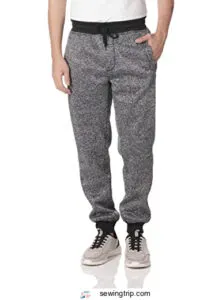
You’ll love the Southpole Black Marled Fleece Jogge, a popular product made of fleece and perfect for lounging or outdoor activities. This jogger features premium fleece fabric that provides a soft and comfortable feel, making it ideal for all-day wear.
It has an elastic waistband for a perfect fit and side deep pockets for convenient storage. The lightweight design ensures comfort during various physical activities such as basketball, football, soccer, jogging, cycling, climbing, hiking.
- Soft and comfortable fabric
- Stylish fit suitable for lounging or outdoor activities
- Elastic waistband provides a perfect fit
- Side deep pockets offer convenient storage
- Some reports of roughness after multiple washes
- Sizing recommendation to order at least one size bigger than usual (may require adjustments)
- Limited color options available
Wrangler Flannel Shirt Jacket
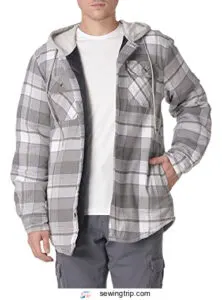
If you’re looking for a versatile and durable outerwear option, the Wrangler Flannel Shirt Jacket is a perfect choice.
- A relaxed fit for comfort
- Heavyweight construction for durability
- Quilted polyester padding for added warmth
- A stylish brushed flannel exterior
- Ample storage space with multiple pockets
- Relaxed fit provides comfort
- Heavyweight construction ensures durability
- Quilted polyester padding offers extra warmth
- Stylish brushed flannel exterior
- Ample storage with multiple pockets
- Arms may be too long for some individuals’ liking
Carter’s Toddler Boys’ Fleece Pajamas
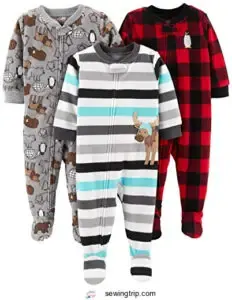
For cozy and comfortable sleepwear options for your toddler, look no further than Carter’s Toddler Boys’ Fleece Pajamas.
These pajamas are made from soft, plush fleece that will keep your little one warm and cozy all night long.
- Soft and plush fleece
- Keeps toddlers warm and cozy all night long
- Playful prints
- Ankle-to-chin zippers for easy changes
- Could be better patterns
- Thick material may be too warm for some toddlers
What is the Difference Between Fleece and Microfleece?
Microfleece is a lightweight, water-resistant, and breathable fabric that’s often used in outdoor gear.
It’s made from a blend of polyester and nylon, and it’s typically thinner and less durable than traditional fleece.
Microfleece is also less warm than traditional fleece, but it’s more breathable and easier to care for.
If you’re looking for a lightweight, breathable fabric for outdoor gear, microfleece is a good option.
However, if you need a warm and durable fabric, traditional fleece is a better choice.
Frequently Asked Questions (FAQs)
What is the difference between fleece and flannel hoodies?
Fleece hoodies are warmer and less breathable than flannel hoodies.
They’re also more durable and wrinkle-resistant.
Flannel hoodies are softer and more breathable, but they aren’t as warm and may wrinkle more easily.
What is the difference between fleece and flannel jackets?
Fleece jackets are lightweight and breathable, while flannel jackets are heavier and more insulating.
Fleece jackets are a good choice for mild weather, while flannel jackets are better for cold weather.
What is the difference between fleece and flannel pants?
Flannel pants are more fashionable and breathable, while fleece pants offer superior warmth.
Flannel is made from natural cotton fibers, providing a cozy feel, while fleece is synthetic polyester with a plush texture.
Choose based on your style preferences and desired level of warmth.
What is the difference between fleece and flannel pajamas?
Flannel pajamas offer cozy comfort without overheating.
The brushed cotton fabric provides a soft and warm feel, perfect for colder nights.
Fleece pajamas, on the other hand, provide superior warmth but may cause sweating and static electricity.
What is the difference between fleece and flannel bedding?
Flannel bedding is made from lightweight, absorbent cotton, providing coziness without overheating.
Fleece bedding is thicker and traps heat effectively but may lead to overheating.
Choose based on your preference for warmth and breathability.
Conclusion
Ultimately, the best fabric for you depends on your individual needs and preferences.
If you’re looking for something soft and warm, flannel is a good option.
If you want something that’s easy to care for and breathable, fleece is a good choice.

